In my previous post, Volleyball Is a Difficult Sport to Photograph, I briefly mentioned a few of the troubles I encountered in trying to photograph a volleyball tournament the other day. I'll expand on that a bit in this post.
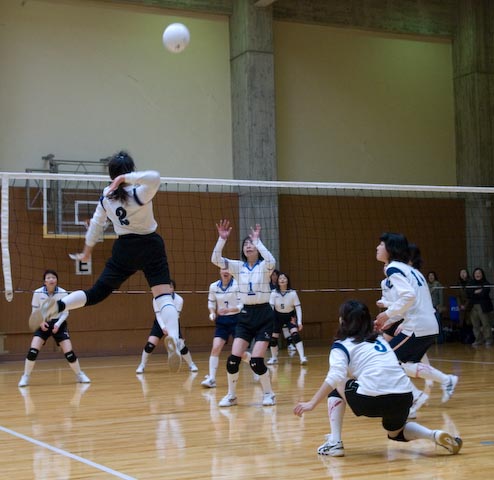
Nikon D200 + Nikkor 17-55 f/2.8 @ 28mm — 1/160 sec, f/4.5, ISO 800 — map & image data — nearby photos
To the tune of “I Believe I Can Fly”....
Here are a few of the considerations that the photographer must balance....
Stand close or far? When standing courtside, the action moves very dynamically, swinging from the far left to the far right, from very close to very far, making it difficult to follow and focus.
Standing far away and using a big zoom makes it much simpler to follow the action, since the entire court falls within a small angle of view. It also makes focusing easier because the action is all the same general distance away. However, being far away reduces flexibility, creates the risk that someone will get in the way.
Fast shutter or slow? Fast freezes the action, leading to crisp images but no sense of movement. Slow yields a sense of movement that can be very nice when it's nice, and very blurry all other times. A slow shutter speed also opens you up to camera-shake-induced blur, which is never nice.
Manual focus or automatic focus? If Automatic, which of the D200's four AF-Area modes? With a dynamic back-and-forth, close-and-far game like volleyball, AF can often lock onto things you don't intend (such an intervening net or stray arm of a player in the foreground), or miss the subject or be too slow to capture the moment.
Large aperture or small? A large, open aperture (low f number) yields a shallow depth of field that can put a distracting background pleasingly out of focus, and it also allows more light (thereby allows for faster shutter speeds and/or lower ISO levels). However, a larger aperture puts a higher demand on pinpoint focusing.
Stopped down (high f numbers) lets more things be in focus, which reduces the demand on focusing accuracy, but also lets in less light, thereby requiring slower shutter speeds or higher ISO levels.
Stand, Kneel, or Sit? Each gives a different perspective, especially when you're close to the court.
High ISO sensitivity or low? The higher the “ISO” (sensor sensitivity setting), the less light is needed for a picture, allowing faster shutter speeds and/or smaller apertures. Images at a high ISO tend to suffer from a grainy effect, which on the D200 starts at about ISO 800 and quickly becomes oppressive.
Zoom in or pull back? Should I try to get the action to fill the frame, or pull back to capture more of the general scene. Getting the shot framed properly the first time yields better quality, but places the demand that the shot indeed be framed properly. A shot of a spiker going up for the kill loses all its impact is the ball is not part of the scene. Pulling the zoom back allows more leeway, but means that the image will need to be cropped for proper framing, and cropping means throwing away data (that is, lowering the quality).
Not zooming in completely also allows room to straighten a crooked image. I seem to have a real problem holding the D200 level... it always just seems to want to be tipped sideways a few degrees, so I need to frame things wide to allow for the rotation.
Follow the action? Especially if you're close to the court, it's totally impractical to try to follow the action with the camera, so that leaves two approaches I can think of: camping and predictive. With camping, you focus (literally and figuratively) on one person and wait for the action to come to them. With predictive setup, you use your understanding of the game to predict where the action will arrive in the next few seconds, and set up for a shot and hope you're correct. (For example, set up on a spiker as the ball is on its way to the setter.)
Camping yields higher-quality images, but you'll miss a lot of opportunities as the action goes on elsewhere. But predictive setup can get very “busy,” leading to camera shake if you're not careful.
Tripod? Monopod? Handheld? I don't have a monopod (UPDATE: I do now), but that might be the way to go. I imagine that a tripod would not be practical except for camping or for far-from-the-court shooting, because predictive setup requires too much side-to-side, and it would be too clumsy, I suspect, to do that while pivoting your body around the tripod's center of axis, rather than swing the camera around your own.
As it was, the tournament was in a small gym, so standing far away and using the my big Nikkor 70-200VR f/2.8 Zoom wasn't an option. Rather, I used my Nikkor 17-55 f/2.8 (non-VR) the whole time. I don't have the steadiest of hands, and it was a typically poorly-lit gym, so could have used VR (anti-shake optical image stabilization technology built into some of Nikon's longer lenses).
For the most part, I was on my knees so that the players would be above me, which yields a more impressive perspective, I think:
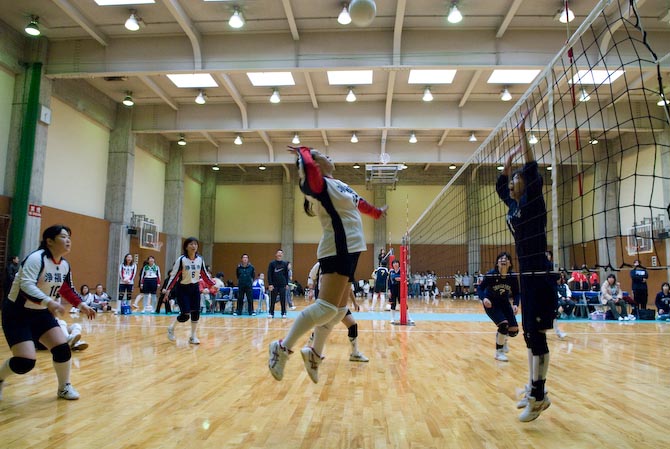
Nikon D200 + Nikkor 17-55 f/2.8 @ 17mm — 1/160 sec, f/5, ISO 1250 — full exif & map
From a low angle of attack, so to speak
(The lady spiking the ball in this shot didn't jump as high as some of the others, but she had positively the most powerful, violent spike. She floated up like a butterfly, and then her arm just exploded out of nowhere to crush the ball.)
Anyway, I started out with a relatively fast shutter, using Auto ISO mode to have the image sensor sensitivity bump up when needed, opting to preserve a fast shutter at the expense of graininess. At 1/160 and 1/200 second, I say “relatively fast” because they're still too slow for really crisp shots, but there just wasn't enough light to go faster. James Carroll recommends at least 1/400 second. Concerning 1/250 second (which is still faster than I ever went), he says “too slow, use only in extremly low lighting. Do not expect good results.” No kidding!
The first game I tried to photograph was one with Doshisha, so it was a bit slower paced and more relaxed than ones I would try later on. Still, I had mostly bad results using auto focus. I tried using the AF-Lock thumb button on the D200 to hold a focus for a bit while doing predictive setup, but either it's a losing proposition all around, or I'm simply not good enough to do it well.
I tried using manual focus, and stopping down on the aperture a bit, but eventually moved to camping mode, where I could get pretty good results with manual focus.
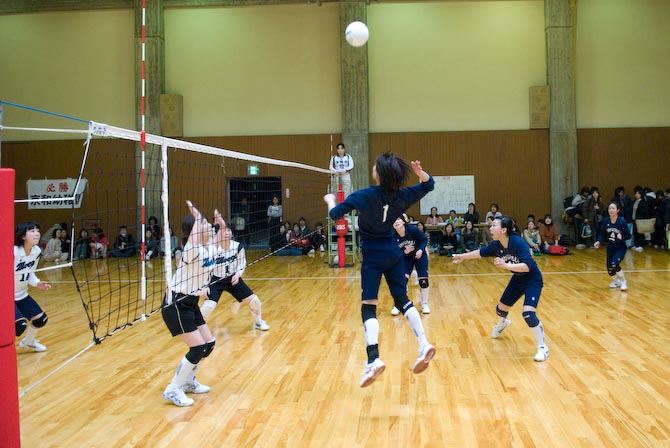
Nikon D200 + Nikkor 17-55 f/2.8 @ 17mm — 1/200 sec, f/2.8, ISO 1250 — map & image data — nearby photos
Fast shutter: no sense of movement
#1 on the blue team had a very powerful spike, but it doesn't look it here.
The next two shots are of the same situation (which came up often between these two teams), one with a fast shutter and one with a slow, 1/25th-second shutter....
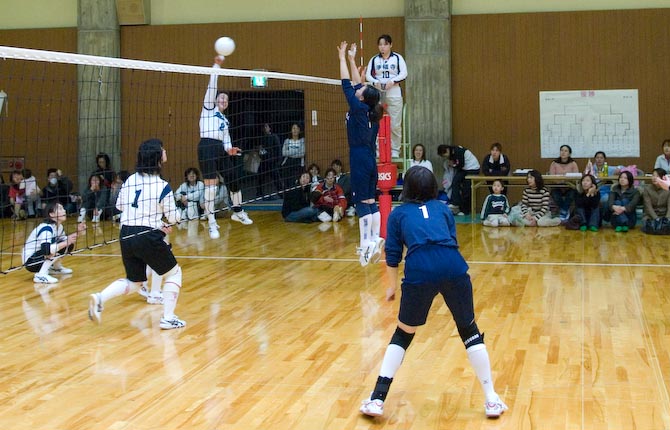
Nikon D200 + Nikkor 17-55 f/2.8 @ 19mm — 1/200 sec, f/2.8, ISO 1250 — map & image data — nearby photos
Here's one with a very slow, 10th of a second shutter, mid spike:
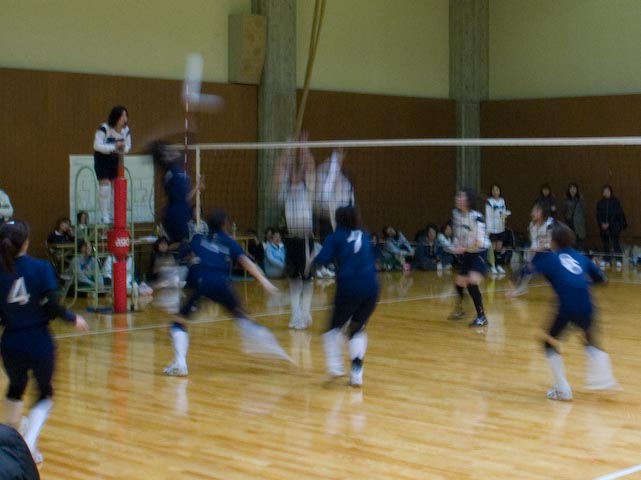
Nikon D200 + Nikkor 17-55 f/2.8 @ 17mm — 1/10 sec, f/11, ISO 640 — map & image data — nearby photos
Very slow shutter yields too much(?) movement
Especially when watching the teams toward the finals, I was really amazed at their defense. It seemed that the back line of both teams could return pretty much anything sent their way, but how could I capture this defensive play in a way that communicates the great athleticism and skill behind it?
The blue team (Moms from Kyoto's Himawari preschool) had a four-up two-back defense, which meant that two people had to cover most of the court at each spike. Much of the skill shown by the two in back was simply knowing where to place themselves, but that doesn't make for very interesting shots....
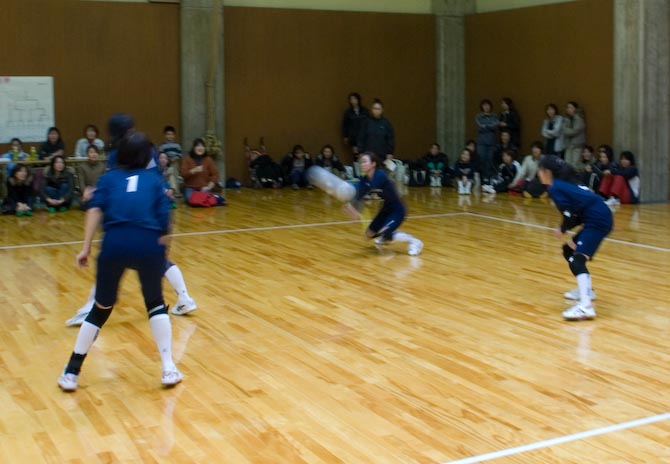
Nikon D200 + Nikkor 17-55 f/2.8 @ 17mm — 1/20 sec, f/6.3, ISO 400 — full exif & map
In the right place at the right time, not coincidentally
I'd come to the conclusion earlier that a fast shutter speed didn't make for very good shots of defensive plays. Here's one of the Doshisha mommies making a great defensive play, but at 1/160 second, it lacks enough movement to be interesting.
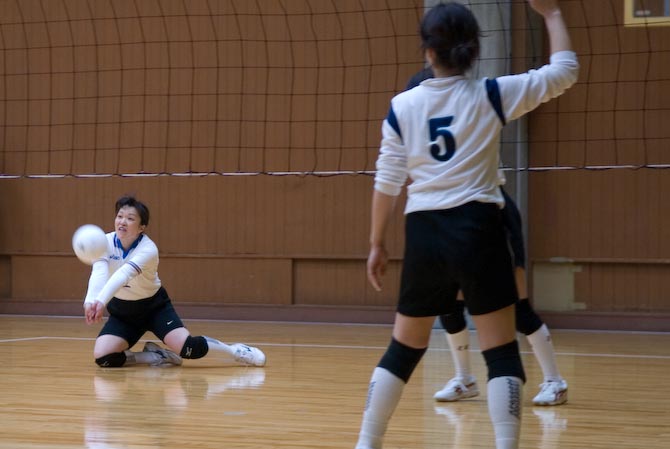
Nikon D200 + Nikkor 17-55 f/2.8 @ 55mm — 1/160 sec, f/2.8, ISO 400 — full exif & map
Fast-Shutter Doshisha defense
Here's one with a shutter speed four times longer (1/40-sec) :
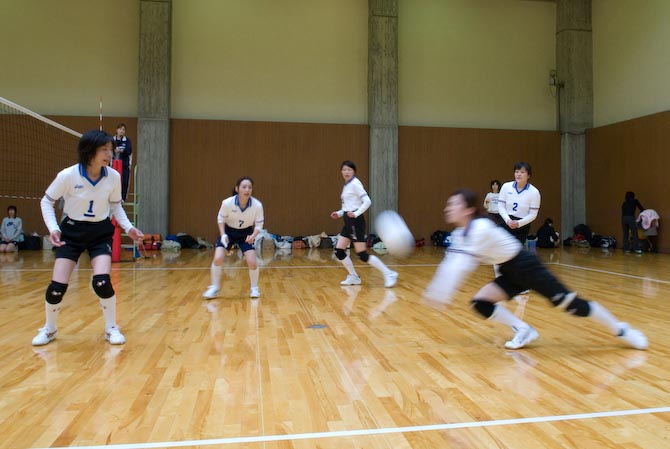
Nikon D200 + Nikkor 17-55 f/2.8 @ 17mm — 1/40 sec, f/7.1, ISO 640 — full exif & map
Slow-shutter Doshisha defense
When watching the finals, I did a bit of predictive setup to try to capture some of the defense: when a team was setting up for the spike, I focused on the other team's defense, and awaited the spike, hoping to capture something interesting.
She wasn't successful making a save in that last one.... she got a hand on the ball, and it went flying into the crowd. Still, most people at this levels — remember, these are just a bunch of moms of preschooler kids — most people would have just stood there watching it go by.
I know I would have! ( I might have taken a picture of it as it went by, though ![]() )
)
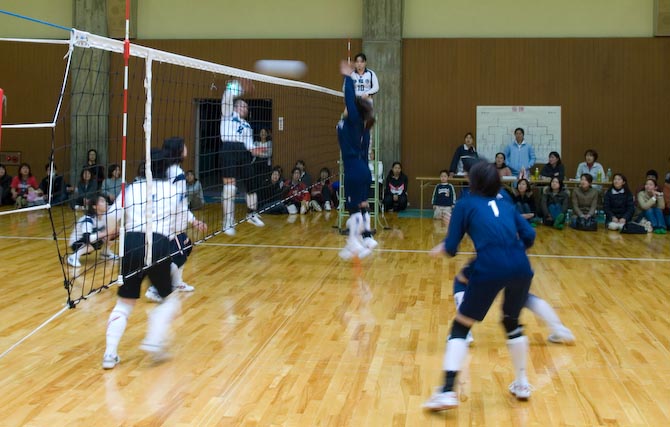
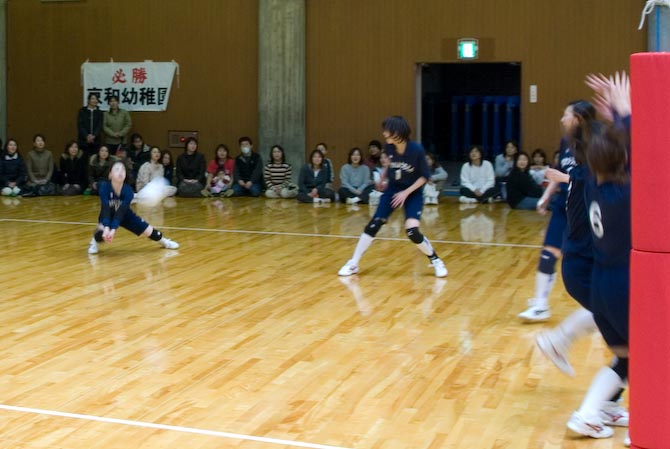
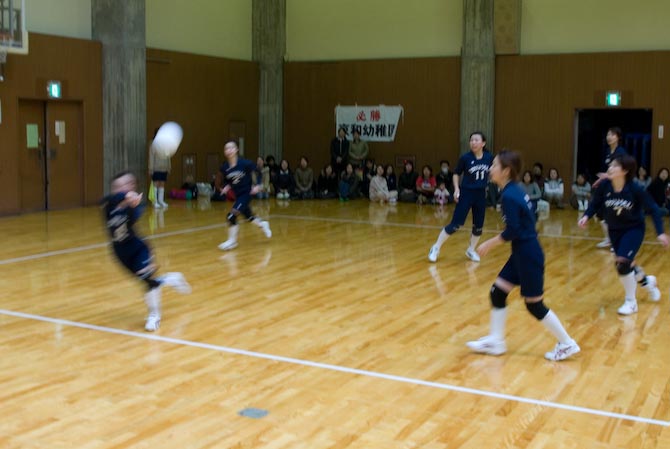
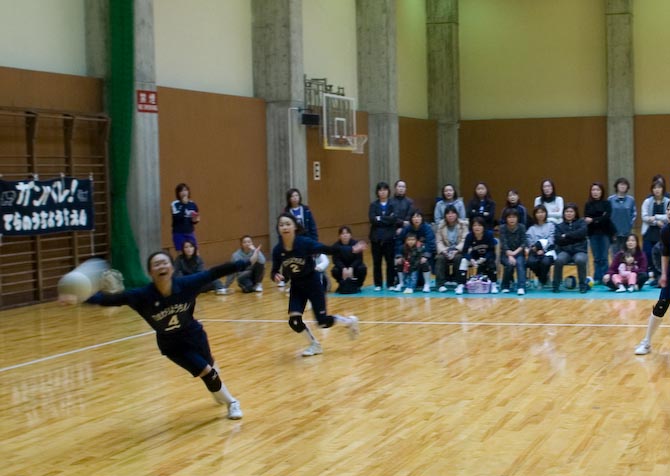
In my opinion, you have some pretty good shots there.
Personally, I’ve found a couple tricks that I try to use when capturing action sports. Fast and slow shutter speeds are the biggest variant and hard enough to learn especially when beginning with fast moving sports. I would suggest starting in Shutter Priority mode until you get comfortable with it — then comes the fun of learning how to vary aperture to blur the background.
With respect to shutter speed, the tricks I’ve found are:
1. Fast shutter speed can make for intense, action stopping shots. But you have to focus close in on the person and get a good facial expression or an interesting pose. For example, in your second shot above, if you were able to get a frontal view of the woman spiking the ball and zoom in so she filled most of the frame, you’d have a winner. Zooming in means that you’d have to capture the ball about a foot from her hand — another hard task. This technique would have also worked for the shot entitled “Great Defense”.
2. Slow shutter speeds are great for action as you captured in a few of the shots. Again though, if the face is out of focus, you loose the personal touch of the shot that will draw in viewers. In volleyball, you could try to capture someone at the peak of a jump to spike the ball — an almost unnoticeable pause where the person seems to hover. Setting the shutter speed correctly will give great arm movement and ball movement while still retaining a mostly focused body. Again, zooming in can make these shots even more amazing.
In general, the best way to shoot sports is to practice a little and figure out what shutter speed is necessary to give the desired amount of motion. Looking at your shots above, it looks like one step faster than 1/40 sec would be about right — ball motion, arm motion but limited body motion.
All in all, these are some great shots of some quite talented players! I’m with you — I’d watch the ball go by with a camera in my hand…
I’m going to my niece’s high school volleyball game this afternoon, 9/21/12. Smithtown East will be visiting North Babylon. Both are on Long Island, east of NYC. Your web site has given me some valuable tips for the photos I hope to take this afternoon. Now all I have to do is assimilate them and make some quick decisions once the action begins. Thanks.